Construction Site Safety Checklist PDF: A Comprehensive Guide for 2024
Introduction to Construction Site Safety
Construction sites are bustling hubs of activity, but they’re also riddled with risks—from falling debris to malfunctioning machinery. Ensuring safety isn’t just about compliance; it’s about protecting lives. Enter the construction site safety checklist, a tool that’s as essential as a hard hat. And guess what? In 2024, these checklists are going digital, with PDFs leading the charge.
Why? Because a well-structured construction site safety checklist PDF doesn’t just tick boxes—it transforms chaos into order. Let’s dig into why this matters and how you can leverage this resource to keep your site incident-free.
Why Safety Checklists Matter
Imagine building a skyscraper without blueprints. Chaos, right? Safety checklists are the blueprints for risk management. Here’s why they’re non-negotiable:
- Accident Reduction: Checklists identify hazards before they escalate.
- Regulatory Compliance: Stay aligned with OSHA and local laws.
- Safety Culture: They foster accountability, making safety everyone’s job.
The Shift to Digital Checklists
Gone are the days of paper checklists buried under coffee stains. PDFs offer:
- Portability: Accessible on phones, tablets, or laptops.
- Easy Updates: Revise protocols in real-time.
- Audit Trails: Digital timestamps prove compliance during inspections.
Understanding the Construction Site Safety Checklist
A construction site safety checklist PDF isn’t a one-size-fits-all document. It’s a dynamic tool tailored to your site’s unique risks. Let’s break down its anatomy.
Core Elements of a Safety Checklist
Every checklist should include:
- Personal Protective Equipment (PPE): Hard hats, gloves, steel-toe boots.
- Equipment Inspections: Cranes, scaffolding, power tools.
- Hazard Identification: Wet floors, exposed wires, unstable structures.
Pre-Construction Preparations
Before the first shovel hits the ground:
- Conduct a site risk assessment.
- Secure permits and brief workers on emergency exits.
Daily Operational Checks
Routine is key. Each morning, verify:
- Machinery functionality (e.g., brakes on lifts).
- Availability of first-aid kits and fire extinguishers.
Key Sections of a Construction Site Safety Checklist PDF
Your PDF checklist should be a roadmap, not a maze. Here’s how to structure it.
Personal Protective Equipment (PPE)
No PPE, no entry. Your checklist must enforce:
- Head Protection: Hard hats with chin straps.
- Visibility Gear: High-vis vests for low-light areas.
- Footwear: Slip-resistant, puncture-proof boots.
Equipment and Machinery Safety
Faulty equipment causes 20% of construction deaths. Prevent this by:
- Daily Inspections: Check for leaks, cracks, or unusual noises.
- Operator Training: Only certified staff should handle machinery.
Maintenance Logs
Track repairs like a hawk. Include:
- Dates of last service.
- Technician signatures.
- Next scheduled maintenance.
Emergency Protocols
When disaster strikes, preparation saves lives. Your checklist should outline:
- Evacuation Routes: Clearly marked exits.
- First-Aid Stations: Stocked and accessible.
- Incident Reporting: Who to contact, and how quickly.
Benefits of Using a PDF Checklist
Why PDFs? Let’s count the ways.
Accessibility and Portability
- Cloud Storage: Access your checklist from anywhere.
- Offline Use: No Wi-Fi? No problem—download it in advance.
Customization and Updates
- Tailor Templates: Add your company logo or site-specific risks.
- Stay Current: Update checklists as regulations evolve—no reprinting needed.
How to Access a Free Construction Site Safety Checklist PDF
Ready to grab your template? Here’s how.
Trusted Sources for Templates
- OSHA.gov: The gold standard for compliance.
- Industry Associations: NSC or AGC offer niche checklists.
- Safety Software Providers: Platforms like SafetyCulture provide editable PDFs.
Customizing Your Checklist
Make it yours:
- Add multilingual instructions for diverse teams.
- Include photos of proper PPE for visual learners.
Implementing the Checklist on Your Site
A checklist is useless if it’s ignored. Here’s how to make it stick.
Training Your Team
- Toolbox Talks: 15-minute safety chats before shifts.
- Digital Demos: Use QR codes to link to training videos.
Monitoring Compliance
- Surprise Audits: Keep teams on their toes.
- Reward Systems: Offer bonuses for zero-incident months.
Legal and Regulatory Compliance
Skip this, and you’re playing with fire.
OSHA Standards
- Fall Protection: Guardrails or harnesses for heights over 6 feet.
- Hazard Communication: Label chemicals clearly.
Consequences of Non-Compliance
- Fines: Up to $15,625 per violation.
- Lawsuits: Injured workers can sue for negligence.
Case Studies: Success Stories
Proof that checklists work.
Reduced Injury Rates
- ABC Construction: Cut incidents by 60% in 6 months using PDF checklists.
- XYZ Builders: Slashed workers’ comp claims by 45%.
Improved Audit Outcomes
- Quick Fix: One company passed OSHA audits in 20 minutes thanks to organized PDF logs.
Conclusion: Enhancing Safety with a Checklist PDF
A construction site safety checklist PDF isn’t just paperwork—it’s a lifeline. By digitizing your processes, you’re not only complying with laws but also building a culture where everyone goes home safe.
Next Steps:
- Download a free template.
- Train your team.
- Review and revise quarterly.
FAQs About Construction Site Safety Checklists
1. Is a safety checklist legally required?
Yes, in most regions. OSHA mandates hazard assessments, and checklists are the easiest way to document compliance.
2. How often should the checklist be updated?
Review it monthly or after any incident. Regulations and site conditions change!
3. Can I use a generic checklist for all projects?
No. A high-rise site has different risks than a residential renovation. Customize accordingly.
4. Who should fill out the checklist?
A designated safety officer or site supervisor. Rotate responsibility to keep everyone engaged.
5. Are digital checklists accepted during audits?
Absolutely. Digital timestamps and e-signatures are often preferred for transparency.
6. What’s the biggest mistake teams make with checklists?
Rushing through them. A 5-minute inspection isn’t enough—be thorough!
7. How do I handle non-English speakers?
Use multilingual checklists or symbols/icons for universal understanding.
8. Can checklists prevent all accidents?
No, but they reduce risks significantly. Pair them with ongoing training for best results.
